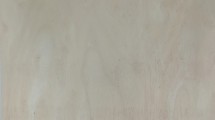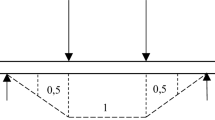Abstract
Four different commercial resin formulations namely cross-linked polyvinyl acetate (XPVAc), melamine urea formaldehyde (MUF), urea formaldehyde (UF) and melamine formaldehyde (MF) were used to produce laminated veneer lumber (LVL) from yellow poplar veneers in the laboratory. Physical and mechanical properties were evaluated using ASTM (D 1037, D 906, D 5456) standards and compared. Internal bond, tensile shear and block shear strengths of specimens subjected to accelerated (boiled water) and cyclic (repeated cold water) conditions were also determined. Strength properties of yellow poplar LVL were improved compared with the solid wood. The properties of XPVAc bonded LVL were superior or comparable to the thermosetting adhesives. This study clearly indicated that cross-linked PVAc can be used to manufacture LVL with acceptable properties.
Zusammenfassung
Vier handelsübliche Harze, vernetztes Polyvinylacetat (XPVAc), Melaminharnstoffformaldehyd (MUF), Harnstoffformaldehyd (UF) und Melaminformaldehyd (MF), wurden zur Herstellung von Laborfurnierschichtholz (LVL) aus Tulpenbaumholzfurnieren verwendet. Die physikalischen und mechanischen Eigenschaften wurden gemäß ASTM (D 1037, D 906 und D 5456) untersucht und verglichen. Querzugfestigkeit, Zugscherfestigkeit und Blockscherfestigkeit der Proben wurden nach schneller Bewitterung (kochendes Wasser) und zyklischer klimatischer Beanspruchung (mehrfach kaltes Wasser) ebenfalls bestimmt. Im Vergleich zu Massivholz zeigte Tulpenbaum-Furnierschichtholz verbesserte Festigkeitseigenschaften. Die Eigenschaften von mit XPVAc verklebtem LVL waren besser oder gleich denjenigen, die mit Duroplasten verklebt wurden. Diese Studie zeigt deutlich, dass vernetztes Polyvinylacetat zur Herstellung von LVL mit akzeptablen Eigenschaften verwendet werden kann.
Similar content being viewed by others
References
American Society for Testing and Materials (1999) ASTM D 1037, Standard test method for evaluating properties of wood base fiber and particle panel materials. ASTM, West Conshohocken, PA
American Society for Testing and Materials (2004) ASTM D 906-98 (Reapproved in 2004), Standard test method for strength properties of adhesives in plywood type construction in shear by tension loading. ASTM, West Conshohocken, PA
American Society for Testing and Materials (2006) ASTM D 5456-06, Standard specification for evaluation of structural composite lumber products. ASTM, West Conshohocken, PA
Anon (2001) USDA Forest Service. Wood Handbook: Wood as an Engineering Material. Forest Product Laboratory, FPL-GTR-113, U.S. Department of Agriculture, pp 751
Barnes HM, Murphy RJ (2006) Effect of vapor boron treatment on some properties of wood strand and fiber composites. Compos Part A 37:1402–1405
Blanchet P, Beauregard R, Erb A, Lefebvre M (2003) Comparative study of four adhesives used as binder in engineered wood parquet flooring. For Prod J 53(1):89–93
Fu F, Bao FC (1999) End use selection of plantation poplar: solid wood or laminated veneer lumber (LVL). Sci Sil Sin 35(4):64–72
Gerhards CC (1983) Effect of high temperature drying on bending strength of yellow poplar 2 by 4’s. For Prod J 33(2):61–67
Hesterman ND, Gorman TM (1992) Mechanical properties of laminated veneer lumber made from interior Douglas fir and lodge pole pine. For Prod J 42(11/12):69–73
Kimmel JD, Janowiak JJ (1995) Red maple and yellow poplar LVL from ultrasonically-rated veneer. For Prod J 45(7/8):54–58
Lam F (2001) Modern structural wood products. Prog Struct Eng Mater 3:238–245
Lee JN, Tang RC, Kaiserlik JH (1999) Edgewise static bending properties of yellow-poplar laminated veneer lumber: effect of veneer-joint designs. For Prod J 49(7/8):64–70
Liu Y, Lee AWC (2003) Selected properties of parallel strand lumber made from southern pine and yellow poplar. Holzforschung 57:207–212
Mansouri HR, Pizzi A, Leban JM (2006) Improved water resistance of UF adhesives for plywood by small pMDI additions. Holz Roh- Werkst 64:218–220
Marra AA (1992) Technology of Wood Bonding: Principles and Practice. Van Nostrand Reinhold, New York
Moody RC, Hernandez R, Davalos JF, Sharma SS (1993) Yellow poplar glulam timber beam performance. Res. Pap. FPL-RP-520. Madison, WI: U.S. Department of Agriculture, Forest Service, Forest Products Laboratory. 28 pp
Ozarska B (1999) A review of the utilization of hardwoods for LVL. Wood Sci Technol 33:341–351
Qiao L, Coveny PK, Easteal AJ (2002) Modifications of poly(vinyl alcohol) for use in poly(vinyl acetate) emulsion wood adhesive. Pigm Resin Technol 31(2):88–95
Serrano E, Enquist B (2005) Contact free measurement and non-linear finite element analyses of strain distribution along wood adhesive bonds. Holzforschung 59:641–646
Wong ED, Razali AK, Kawai S, Wong ED (1996) Properties of rubber wood LVL reinforced with Acacia veneers. Wood Res 83:8–16
Wu Q, Piao C (1999) Thickness swelling and its relationship to internal bond strength loss of commercial oriented strandboard. For Prod J 49(7/8):50–55
Author information
Authors and Affiliations
Corresponding author
Rights and permissions
About this article
Cite this article
Shukla, S.R., Kamdem, D.P. Properties of laboratory made yellow poplar (Liriodendron tulipifera) laminated veneer lumber: effect of the adhesives . Eur. J. Wood Prod. 67, 397–405 (2009). https://doi.org/10.1007/s00107-009-0333-1
Received:
Published:
Issue Date:
DOI: https://doi.org/10.1007/s00107-009-0333-1




